There are literally hundreds (thousands?) of edible mushroom varieties around the world. Wood ears are one of them – and they can be found in the wild, if you know your foraging stuff. Or know a mycologist who can accompany you on your trek into the forests to find them.
If you’re not particularly familiar with this species of mushroom, you’ve come to the right place. We’ll dive into all the details of what they are, how they can be found, where they can be found, what the benefits they provide are, and much more.
Let’s dig in.
Wood Ear Mushroom Classification
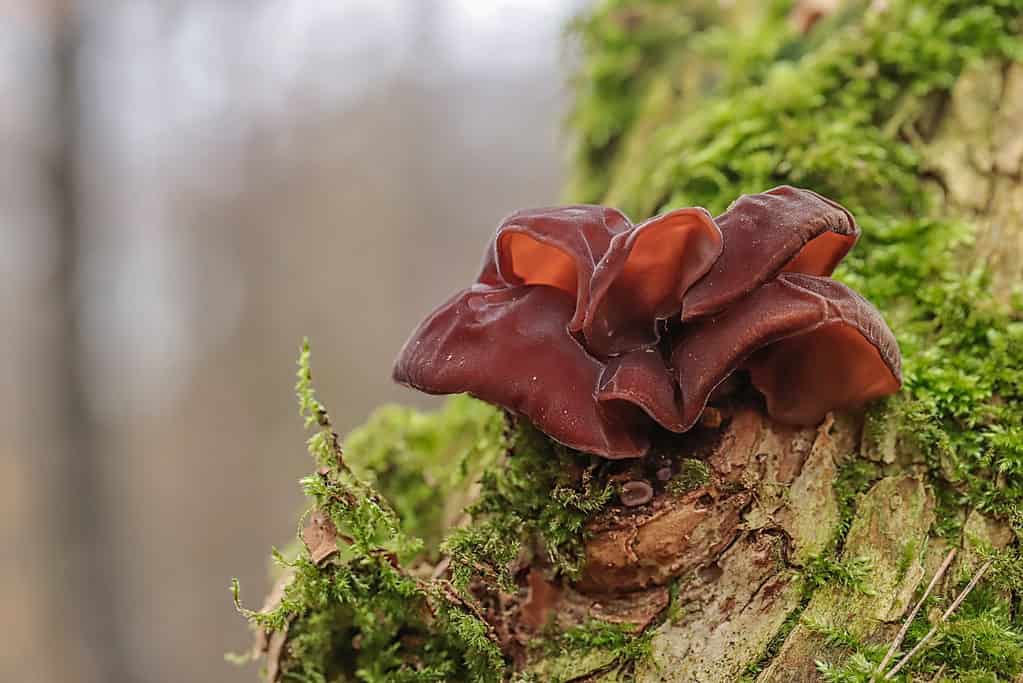
The auricularia auricula-judae or wood ear mushroom growing on a piece of decaying wood.
©Marek Mierzejewski/Shutterstock.com
Wood ears, or Auricularia auricula-judae, are also know as Judas’s ear, Jew’s ear, or jelly ear mushrooms. They belong to the order Auriculariales. They grow on wood, particularly living elder trees, and may be found throughout the year in Europe.
Where Do Wood Ear Mushrooms Grow?
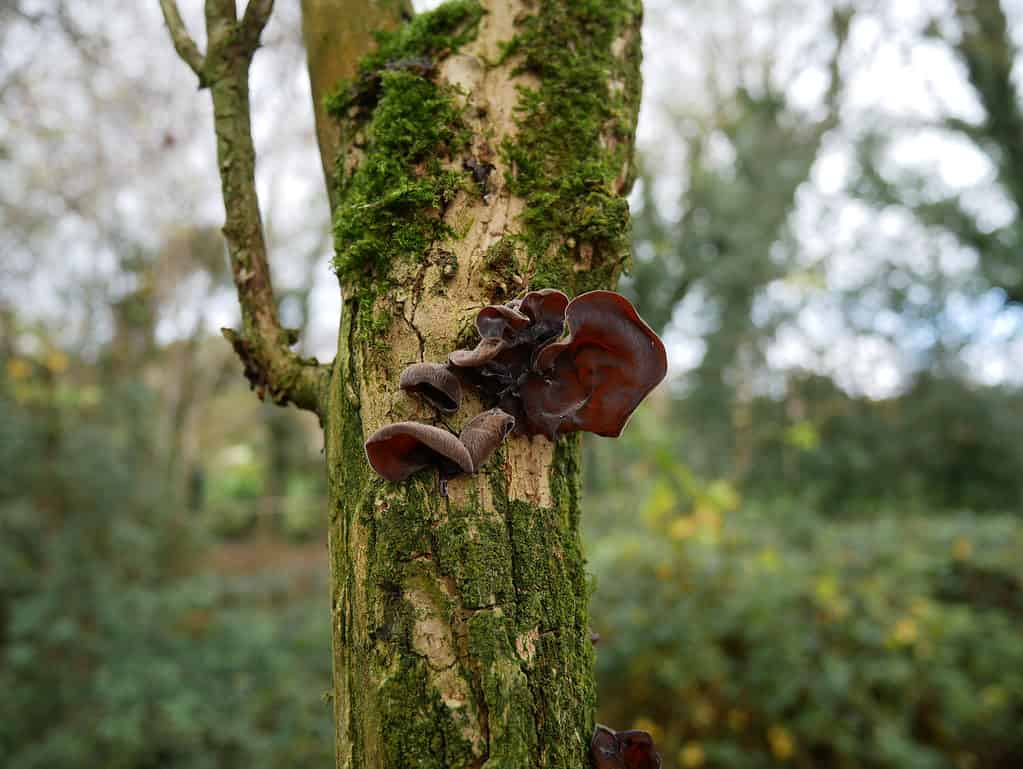
The mushroom grows on a moss covered elder tree in the woods.
©Brapaceae/Shutterstock.com
Particularly fond of elder trees, wood ear mushrooms grow in forests and swampy areas where these trees may be found. They may be found, however, on other trees and shrubs, primarily in Europe, North America, and Asia.
The mushroom is native to temperate, humid forests of Asia and were brought over to Europe, Africa, Australia, New Zealand, and North America as cultivars that the rest of the world might more easily enjoy these unique mushrooms.
They thrive on broadleaf tree species and conifers in warmer, humid climates.
Are Wood Ear Mushrooms Safe to Eat?

They’re often used in a stir fry.
©suttirat wiriyanon/Shutterstock.com
Wood ear mushrooms are absolutely safe to eat, though they are not the most commonly cultivated or foraged for mushrooms. This means that they may be more plentiful in some areas in the wild, but much more difficult to purchase from farmer’s markets or specialty stores.
What Do Wood Ear Mushrooms Taste Like?
Wood ear mushrooms have a natural, earthy, mild flavor that helps to make them particularly versatile in cooking. They soak up the flavors of the ingredients, helping it to add unique texture while enrichening the overall flavor of the stew, soup, stir fry, or other meal.
Benefits of Wood Ear Mushrooms
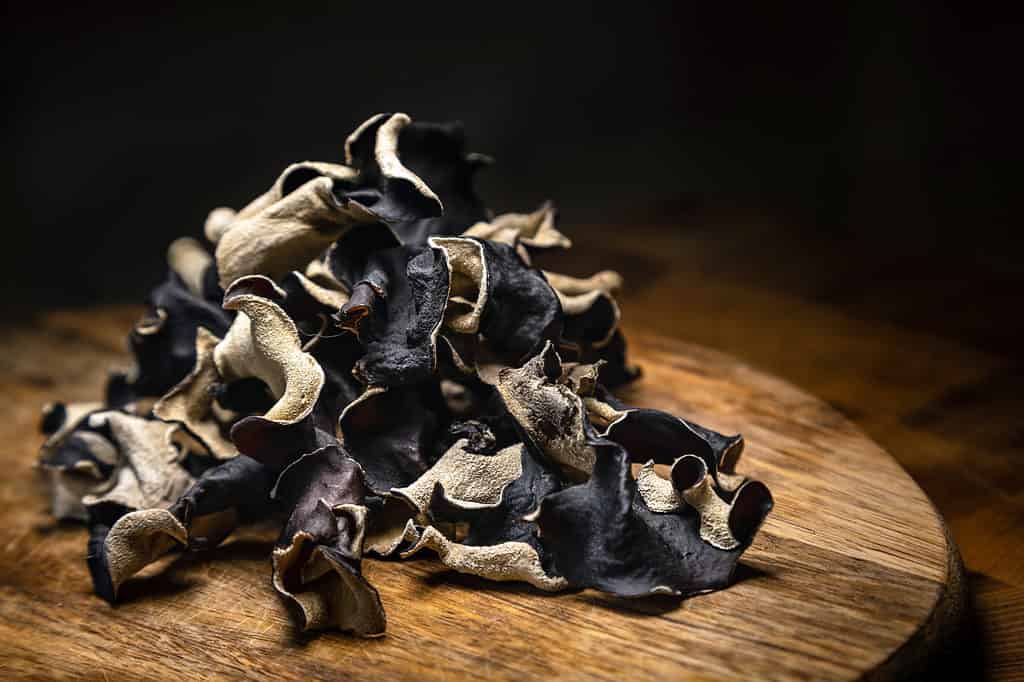
Dried mushrooms are exported all over the world.
©Ja Crispy/Shutterstock.com
Wood ear mushrooms are loaded with protein and fiber, magnesium, iron, and B vitamins. Because of these and other properties, wood ear fungus has been used in traditional medicine for many centuries. The scientific studies on the fungi are still in the early years, but there are many claims based on the nutritional profile that they may help improve overall health by regular consumption.
They contain high concentrations of antioxidants, for one, which suggests they can help fight inflammation, may support immune and gut health, reduce the risk of certain cancer and chronic diseases, and may promote brain health and liver health. Some claims also suggest that the mushroom can help lower blood cholesterol.
These benefits are not distinct to wood ear mushrooms, but rather generally claimed by most foods containing similar levels of the same nutrients. They may help boost health, but they are not a substitute for medications. Always consult a medical care provider before changing your prescription usage.
How Are Wood Ear Mushrooms Used?
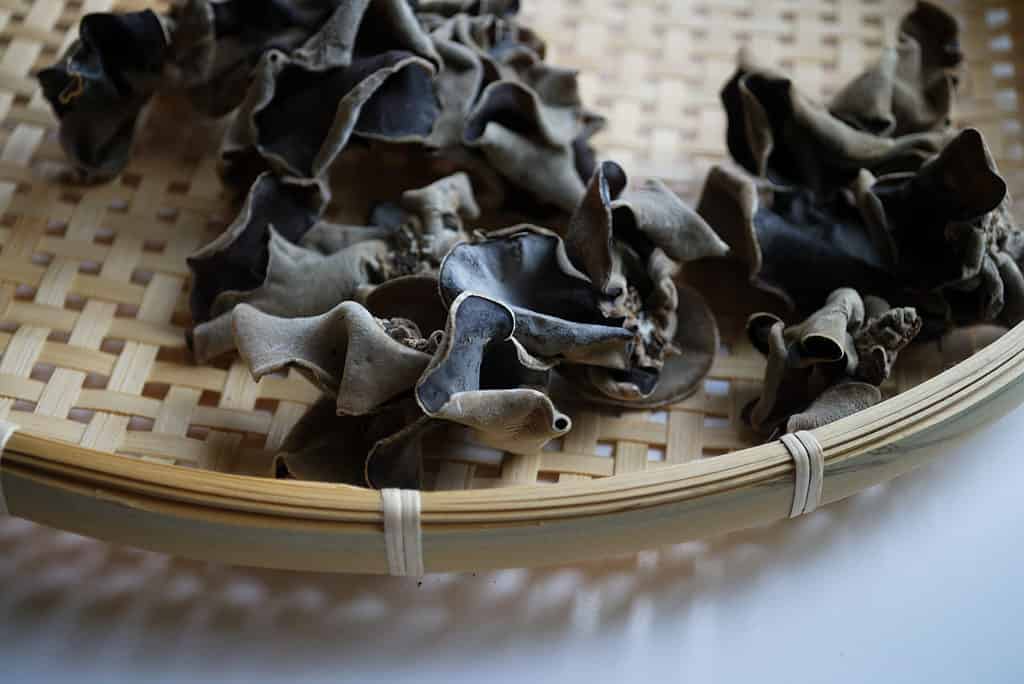
Dried and fresh mushrooms contain many nutrients.
©Nguyen Quynh Tra My/Shutterstock.com
Wood ear mushrooms are high in fiber and protein but low in calories overall. The rich nutritional profile makes them a great addition to meals to help boost the quality of given foods as well.
Wood ear mushrooms have a chewy toothsome texture, so they are often added to soups, salads, stir fries, and stews. Because of their particularly absorbent nature, they’re especially great for anything in the slow cooker in which they have loads of time to soak up the flavors.
A specific favorite for the mushroom include Chinese hot and sour soup.
These mushrooms are low in calories and high in protein and fiber. Wood ear mushrooms are also rich in minerals like iron and magnesium and contain a high concentration of B vitamins. The natural flavor of wood ear mushrooms is earthy and mild. However, the wood ear mushroom is a versatile cooking ingredient that easily soaks up the flavors of other ingredients, making it a perfect addition to soups and stews.
Where to Buy and How Much Do Wood Ear Mushrooms Cost?
You’ll find wood ear mushrooms for sale in specialty shops and online, usually in the dried format. They tend to range in price between $1.00 per ounce and $2.00 per ounce, depending on whether or not you buy in bulk.
How to Identify Wood Ear Mushrooms
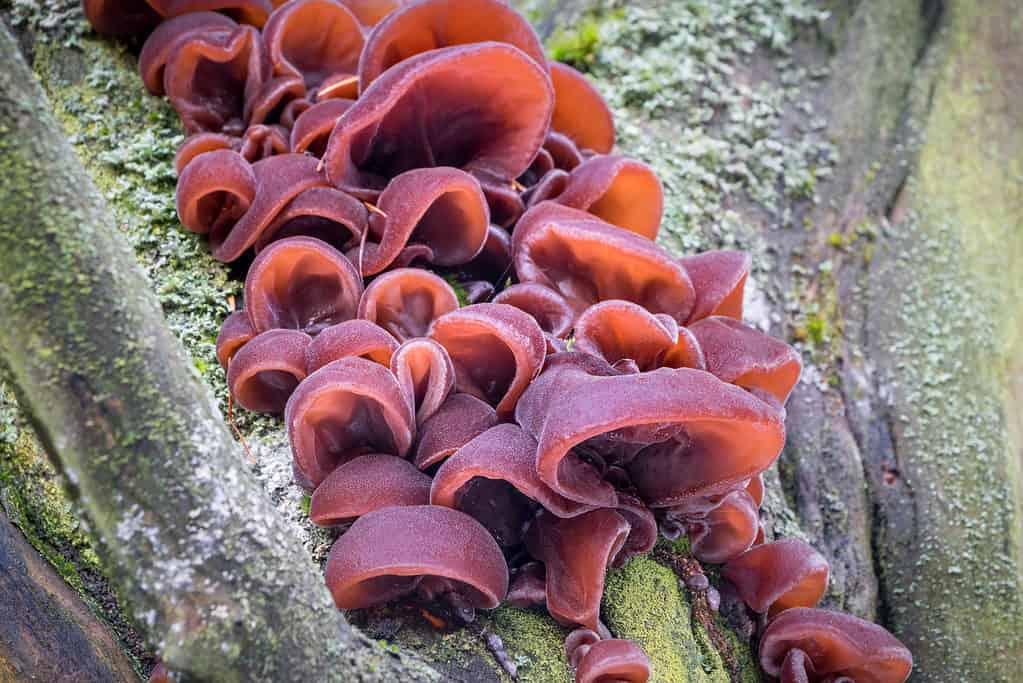
You’ll notice the elements of decay around the mushroom here.
©Jaroslav Machacek/Shutterstock.com
Wood ear mushrooms have a rubbery texture that almost vibes with jelly (gelatin), but they bounce back to their proper shape when they’re squeezed, unlike many other mushrooms that simply “squish” and flatten out. The species that look similar to wood ear mushrooms don’t bounce back, which helps in identifying wood ears from others.
All the mushrooms are brown in color, have thin, gelatinous flesh, and are literally in the shape of human ears. The texture is rubbery and the shape may be an imperfect ear (rumpled, irregular, or distorted in some way) and may be a bit droopy or floppy. Some are more fan-shaped or oblong, some more wrinkled or wavy, but all resemble human ears in some way, including in the fact that human ears have this kind of variance as well.
The tops of the ear shape will be lightly hairy with the underside smooth and wrinkled or veiny. As young mushrooms, they’re often frosted or silvery as well, like they’ve been dusted with a fine coating of pale powder.
The mushroom will grow in clusters of may grow singularly. They remain ear-shaped, however, even in clusters, which is important to note since their lookalikes will grow in clusters and lose their shape.
When the mushrooms are dried out, they become darker in color, even turning charcoal or black. They will dry out naturally on logs and turn black as they lose moisture. Note that black wood ear mushrooms are the same species, they’re just more mature and therefore darker.
Occasionally, all-white albino specimens may occur in the wood ear mushroom family. They look similar to white snow fungus but are not the same species.
Where to Forage for Wood Ear Mushrooms
These mushrooms grow only on wood, whether dead or living trees. If you find a mushroom that looks like it anywhere else, it is one of the lookalikes and may be poisonous. They prefer hardwoods and conifers, and are particularly fond of elder trees in Europe, but there’s no known favorite in North America.
Wood Ear Mushroom Trivia
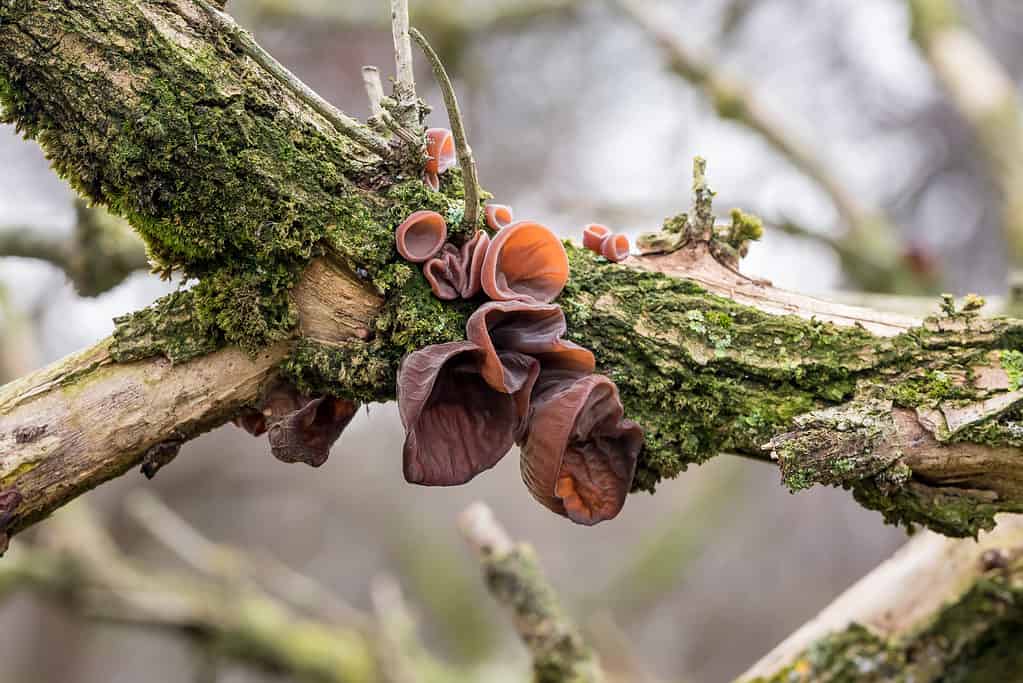
The various aging stages of the mushrooms together.
©Jolanda Aalbers/Shutterstock.com
As mentioned above, the wood ear mushroom also has the nickname of Judas’s ear or Jew’s ear mushrooms. The folklore behind this is connected to Judas Iscariot of the Bible. Iscariot hung himself, supposedly, on an elder tree, and so the mushroom is the returned spirit of Judas, growing on the familiar tree. Some claim its medical use as a cure for sore throats is poetic and “no coincidence.”
In Korean, the name for these mushrooms translates to “wood jellyfish” or “tree jellyfish.” The texture and appearance aren’t too far off some species of jellyfish, so, it makes perfect sense!
In New Zealand, the Maori people call the mushroom hakeke. The mushroom once played an important role in the Taranaki area of New Zealand. When Chinese immigrants came to Taranaki in the 1870s, it is believed one man, Chew Chong, discovered the fungi growing in the wild and recognized it. He organized locals to help him gather the mushroom and ship it to China, bringing in income for the local region. The mushroom was exported from New Zealand to China until the 1960s.
The mushrooms grow on dying and decaying trees, not generally healthy ones. So, if you spot some on a tree that looks “okay,” you likely won’t find that tree alive for long.
Wood ear mushrooms and other saprobic fungi (mushrooms that grow on dying trees) are important for the ecosystem, as they help break down the densest materials of the rotting trees.
Up Next:
- Beech Mushrooms: A Complete Guide
- Mushroom Hunting in Texas: A Complete Guide
- Mushroom Hunting in Pennsylvania: A Complete Guide
- What is the Best Month for Mushroom Hunting?
The photo featured at the top of this post is © Jaroslav Machacek/Shutterstock.com
The information presented on or through the Website is made available solely for general informational purposes. We do not warrant the accuracy, completeness, or usefulness of this information. Any reliance you place on such information is strictly at your own risk. We disclaim all liability and responsibility arising from any reliance placed on such materials by you or any other visitor to the Website, or by anyone who may be informed of any of its contents. None of the statements or claims on the Website should be taken as medical advice, health advice, or as confirmation that a plant, fungus, or other item is safe for consumption or will provide any health benefits. Anyone considering the health benefits of particular plant, fungus, or other item should first consult with a doctor or other medical professional. The statements made within this Website have not been evaluated by the Food and Drug Administration. These statements are not intended to diagnose, treat, cure or prevent any disease.
Sources
- Mushroom Appreciation, Available here: https://www.mushroom-appreciation.com/wood-ear-mushrooms.html
- Specialty Produce, Available here: https://specialtyproduce.com/produce/Wood_Ear_Mushrooms_720.php
- Masterclass, Available here: https://www.masterclass.com/articles/wood-ear-mushroom
- Vin Mec, Available here: https://www.vinmec.com/en/news/health-news/nutrition/what-is-the-effect-of-eating-wood-ear/
- NZ Nature Guy, Available here: https://www.nznatureguy.com/2019/06/29/6-facts-new-zealands-wood-ear-fungus/
- Mycelium Society, Available here: https://www.myceliumsociety.com/2022/01/17/exidia-or-wood-ear.html
- Wikipedia, Available here: https://en.wikipedia.org/wiki/Auricularia_auricula-judae
Thank you for reading! Have some feedback for us? Contact the AZ Animals editorial team.






